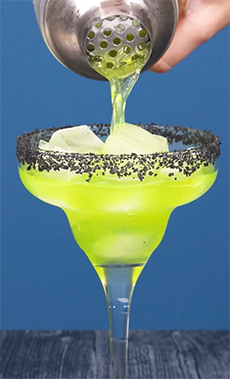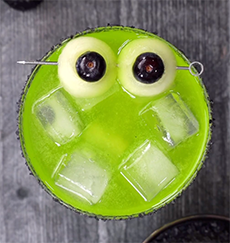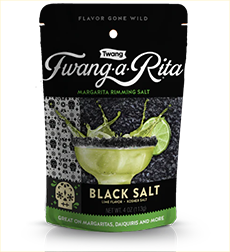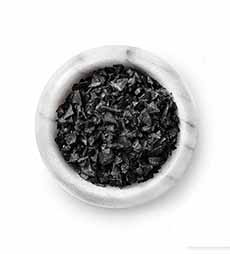A Halloween Margarita With A Black Salt Rim
|
|
Cast a spell with a seasonal spooky Margarita, using a black salt rim and melon liqueur instead of orange liqueur. For Halloween and Día De Los Muertos approaches, Twang-A-Rita employs its Black Salt to snazz up the holidays. Cheers to spirited sips and otherworldly adventures! > The different types of salt. > About beer salt: A NIBBLE review. > More Halloween cocktail recipes. Preparation 1. CREATE the eyeballs. Scoop small balls from a honeydew melon. Create a small space and place a blueberry in the center of each melon ball to resemble an eyeball. Skewer the melon eyeballs onto a cocktail pick and set aside. 2. RIM a Margarita glass or a rocks glass with Twang-A-Rita Black Salt. Fill the glass with ice. 3. COMBINE the tequila, melon liquor, lime juice, and agave syrup in a cocktail shaker. Shake for 10-15 seconds. 4. POUR into the glass, add the melon pick, and serve. Black salt refers to a variety of unrefined mineral salts that range from dark grey to black in color, including Hawaiian volcanic sea salt (a.k.a. black lava salt) and Cyprus black sea salt. Hawaiian black flake salt, also called black lava salt, is a sea salt harvested from the Pacific Ocean surrounding the Hawaiian islands that is blended with activated charcoal derived from coconut shells. This gives the salt its distinct black color. Cyprus black flake salt, harvested from the Mediterranean Sea off the coast of Cyprus, is unique, with large black pyramid-shaped flakes that provide lots of crunch. The sea sat is processed with carbon, which is obtained from naturally processed charcoal from soft woods such as birch, linden, and willow. Kala namak, also called Himalayan black salt, is a variety that is not black but ranges from pink to dark violet in color. It has been used for hundreds of years in Asian cuisines for its distinctive flavor. In India, it is predominantly used in chaats, chutneys, raitas, and other savory dishes. Made from crushed Indian volcanic rock salt, when mined it is actually reddish-black in color but takes on a pink hue upon being ground. It consists of primarily sodium chloride, plus trace impurities of sodium sulfate, sodium bisulfate, sodium bisulfite, sodium sulfide, iron sulfide, and hydrogen sulfide. Sodium chloride provides a salty taste, iron sulfide provides a dark violet hue, and all the sulfur compounds give it a slightly savory taste as well as a highly distinctive aroma (like hard-boiled eggs), with hydrogen sulfide being the most prominent contributor to the latter. The acidic bisulfates/bisulfites contribute a mildly sour taste. |
|
|
CHECK OUT WHAT’S HAPPENING ON OUR HOME PAGE, THENIBBLE.COM.
|
||






